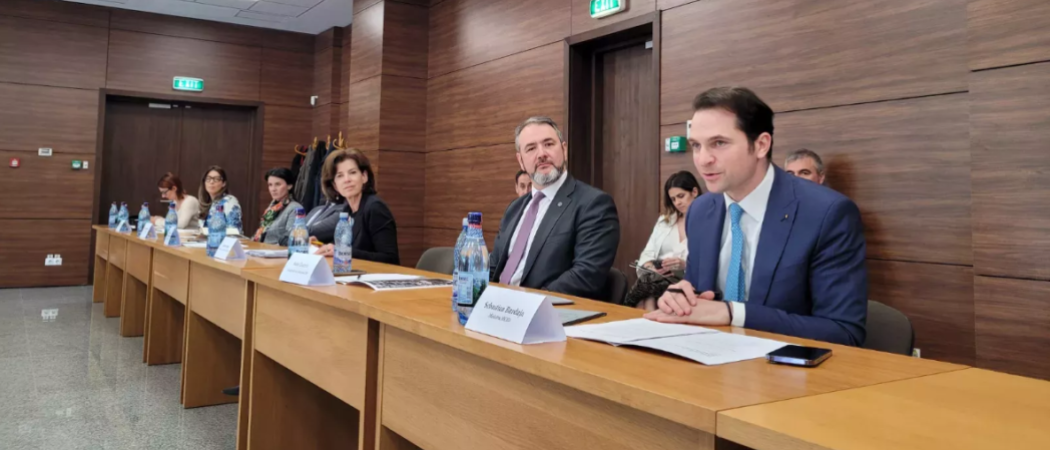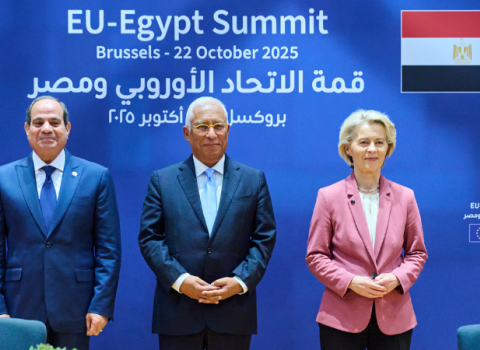A new deal brings hope a €300M EU investment in eastern Europe’s largest research laboratory will not be lost to management problems

Romanian research minister Sebastian Burduja (right) speaking at a meeting with representatives of EuroGammaS last week. Photo: Romanian Government
Romania’s national institute of physics and nuclear engineering IFIN-HH and the EuroGammaS consortium have reached an agreement that could end years of litigation over equipment that is meant to complement one of the world’s most powerful research lasers at the Extreme Light Infrastructure (ELI-NP) in Bucharest.
The agreement unlocks a tense situation that has dragged on since 2015 over a laser beam EuroGammaS was contracted to build and install at ELI-NP. The breakthrough is thanks to an “extraordinary team effort” at diplomatic, legal and administrative levels, said Romania’s research minister Sebastian Burduja after a meeting at ELI-NP with representatives of the EuroGammaS consortium last week.
ELI-NP was the first research infrastructure to be built with EU structural funds and was meant to be part of a European Research Infrastructure Consortium, ELI-ERIC, linking together the laser lab in Romania with counterparts in Czechia and Hungary.
However, Romania has so far failed to complete the installation of all the components of the laboratory, missing the requirements for joining ELI-ERIC. The European Commission approved the launch of the ERIC in 2021 based on an international application that excluded Romania from the group of founding members.
Now, the Romanian government hopes it can join ELI-ERIC by the end of this year “with a bit of luck”, a source in the prime minister’s cabinet told Science|Business.
“Today we have all the ingredients for unparalleled scientific achievements that Romania will be honoured to showcase to Europe and the world,” Burduja said.
The agreement could pave the way to stop litigation in Romanian courts and enable the cooperation between ELI-NP and EuroGammaS to continue, according to Pierluigi Campana, director of research at the Italian national institute for nuclear physics INFN, one of the leading partners in the EuroGammaS consortium.
The proposal agreed by both sides will be submitted to the Romanian court where a judge needs to rubberstamp the amicable resolution of the litigation. “Research is not done in tribunals,” said Campana, who is looking forward to restart cooperation with colleagues in Bucharest and install multimillion-euro equipment that’s been sitting unused for years.
Bad blood
Romania has made mistakes over the management of a contract with EuroGammaS for the building of a gamma beam, which is secondary to the main high intensity laser system at ELI-NP. Now, thanks to diplomatic efforts over the past year, the two parties seem to be ready to bury the hatchet and move on with the project.
The gamma equipment was delivered at the site but was never installed due a disagreement between IFIN-HH and EuroGammaS after the pan-European consortium noticed the building was not compliant with the technical specifications of the equipment and postponed the installation.
IFIN-HH asked for delay penalties and threatened to cancel the €67 million contract, while EuroGammaS filed a legal suit in a court in Bucharest asking for an extension of the contract and reimbursement of all the money it had to pay in fines for late delivery.
The equipment which was part of the first stage of the €67 million contract, has been sitting in unopened wooden crates at ELI-NP, while the former director of the research lab, Nicolae Zamfir moved to sign a €42 million contract for an alternative gamma ray system with a Californian company Lyncean Technologies. Lyncean filed for bankruptcy in November last year, adding another layer of complication to an already messy situation, but sources say the company would still be able to deliver and install the equipment.
Now, after intense diplomacy, the Franco-Italian consortium EuroGammaS has been invited back to the negotiation table to ensure the gamma beam is delivered by the end of this year.
Campana says the value of the deal is still under discussion, but it will allow EuroGammaS to claw back the penalties imposed when the contract was cancelled. In addition, ELI-NP will have to adapt the building in the coming months so the gamma equipment can be installed according to EuroGammaS requirements.
If the deadline for this is not met, the European Commission could demand parts of the €300 million cost of ELI-NP is returned to the EU budget.
ELI-ERIC director Allen Weeks said it’s very important that the row is resolved in an amicable way. The Bucharest facility is already involved in joint scientific projects with the Czech and Hungarian partners, while the new political agreement gives further hope the laser research consortium will be made whole soon.
“The political decision of Romania joining ELI-ERIC needs to be agreed between the host countries, but with the scientific collaboration already showing success, that will help the governments to come an agreement,” Weeks told Science|Business.





 A unique international forum for public research organisations and companies to connect their external engagement with strategic interests around their R&D system.
A unique international forum for public research organisations and companies to connect their external engagement with strategic interests around their R&D system.